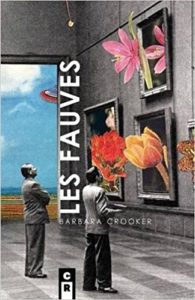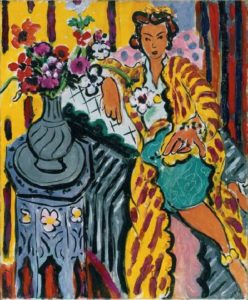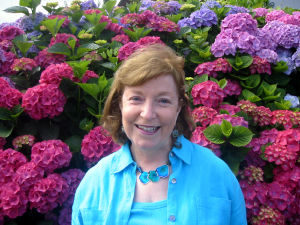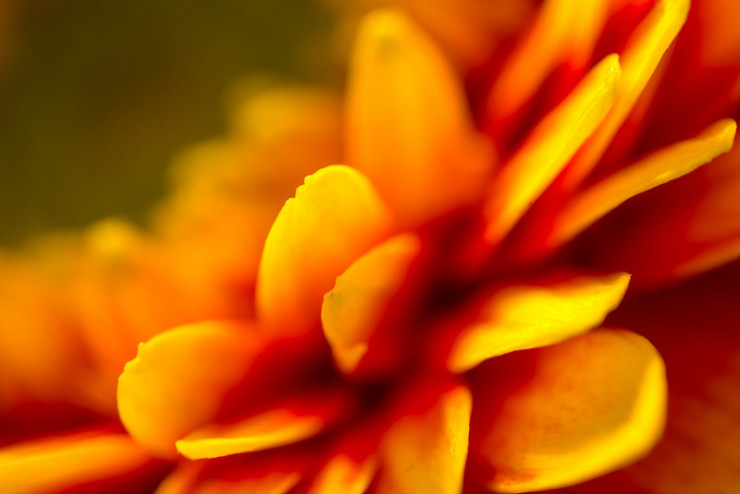It had been 30 years since we had been in London. One site on my “must-see” list was the Tate Modern, that monumental museum dedicated to modern and contemporary art, occupying a former power plant on the south bank of the Thames, directly across the Millennium Bridge from St. Paul’s Cathedral. Even if you don’t like contemporary art, the museum is stunning. The major exhibition at the time was the works of the Norwegian artist Edvard Munch, which I would see two days later. On my first day there, I simply wanted to experience the museum itself.
I wandered. And in the corner of a large room I came upon a painting by the British painter Meredith Frampton (1894-1984) entitled Marguerite Kelsey. Kelsey (1908?-1995) was a professional model, and this painting of her from 1928 simply stunned me. I stood in front of it for a good 15 minutes, and then resumed my wandering. I went back to it before I left, and I would return twice more during that trip to see it. Two years later, I had a similar experience with Interior 1981 by the German painter Anselm Kiefer, during an exhibition of his work at the Royal Academy of Art. As it turned out, that painting was part of Kiefer’s leading Germany to confront its Nazi past.

Fauvism and its adherents, “les fauves” or “the beasts,” were inspired by the late work of Vincent van Gogh, George Seurat, Paul Gauguin, Paul Cezanne, and other Impressionists and Neo-Impressionists. It was most closely associated with Henri Matisse, Georges Rouault, and other Modernist painters. Fauvism emphasized the use of strong colors and moved away from the representational art of the Impressionists.
Crooker has organized her poems into four sections. The first and the last are devoted to Fauvist paintings as subjects and themes, especially ones by Matisse and late ones by van Gogh. It’s as if we’re on a tour by the exhibition curator, and we follow her as she walks to each painting, considers it, and then turns to us to explain or perhaps simply to start or resume a conversation, as she does in this poem about a painting by Henri Matisse.
Odalisque avec Anemones, 1937

Odalisque avec Anemones, oil on canvas (1937) by Henri Matisse; Philadelphia Museum of Art.
Delacroix said Banish all earth colors, and Matisse
took this to heart, not a smear of clay, dirt or sand
anywhere in this painting. Anemones—red, orange, purple—
drape themselves in front of the woman lounging
on the divan, her red-striped yellow wrapper falling open.
The yellow wallpaper, too, is striped, a tiger ready to pounce.
And isn’t this the color of happiness? Like the sun
that lacquered the vineyards, filled the grapes, tightened
their skins. That glanced off the sea as we sat in the café,
the one with the surly waiter in the striped jersey
who wouldn’t bring us bread, then brought the wrong wine.
But the day was warm, and our lunch, when it came—
grilled sardines drizzled with oil—was just what we wanted,
and we were happy in the sun on the white wicker chairs,
something blooming in my heart, anemones
spilling from their vase.
Crooker asks if this is the color of happiness, and it is a question worth pondering. The near-riot of color in the Matisse painting is overwhelming, but I don’t know whether I see happiness as much as I see a kind of desperation to give the appearance of happiness.

Barbara Crooker
In between the two sections devoted to ekphrastic poems are two containing poetry of a more general nature. These include several delightful poems about language, including “Seventeen Phrases You’re Probably Saying Wrong” and “The Bossy Letter R.”
Crooker has published numerous poetry collections, including The Lost Children (1989), Obbligato (1991), In the Late Summer Garden (1998), Ordinary Life (2001), The White Poems (2001), Radiance (2005), Line Dance (2008), More (2010), Gold (2103), Small Rain (2014), and Selected Poems (2015). Her poems have been published in numerous literary journals and magazines. She’s won numerous poetry prizes, fellowships, and residencies, and has even been nominated for a Grammy award.
In Les Fauves, Crooker demonstrates how poetry about art can surprise, stun, and overwhelm us. It can simultaneously deepen our understanding of and love for art. The collection makes me want to see “Marguerite Kelsey” again.
Photo by Olli Henze, Creative Commons, via Flickr. Post by Glynn Young, author of the novels Dancing Priest and A Light Shining, and Poetry at Work.
__________________________

“I require all our incoming poetry students—in the MFA I direct—to buy and read this book.”
—Jeanetta Calhoun Mish
- Poets and Poems: Katie Kalisz and “Flu Season” - April 15, 2025
- Poets and Poems: Michelle Ortega and “When You Ask Me, Why Paris?” - April 10, 2025
- Robert Waldron Imagines the Creation of “The Hound of Heaven” - April 8, 2025

Bethany R. says
I enjoy Barbara Crooker’s poetry, and am glad to read this post.
I looked at the painting, “Marguerite Kelsey,” online, and it is stunning. How can paint do that? The way the light hits the subject, it seems like a surreally flawless photograh.
I find the idea of writing ekphrastic poetry kind of exciting. Having your subject in front of you, can be freeing, in a way. I wonder if poets generally include a picture/link to their subject in order for the reader to more fully take in their poem? Does Les Fauves do that? If not, I would enjoy looking them up as I read through.
Lane Arnold says
Recently I listened to Marilyn Chandler McEntyre’s recorded lectures entitled “The Poet and the Painter,” which she offered at Regent College, Vancouver, BC. Her talks opened up the world of ekphrastic poetry, alongside lectio/art/literature. I’m savoring time in her Poetry/Art volume In Quiet Light: Poems on Vermeer’s Women. Thank you for the introduction to Barbara Crooker and to Meredith Frampton. Now I’ll have a new volume to discover.
Sandra Heska King says
Is there a link to that, Lane, or do we need to download them? I’ve heard Marilyn speak at Laity Lodge and FFW. I could listen to her all day.
Sandra Heska King says
I haven’t had much time to get to know Crooker. But this makes me want to hurry. Her poem is as colorful as that painting. So many lines to savor.
Robert E Buntrock says
I was alerted to Les Fauves by one of the poems in it, “Falling in love with a chemist”, which as a chemist with a non-scientist wife (now deceased) and it spoke to me. I had to buy the book since no library in Maine has it (or any other of her books). One of the best purchases ever. For the poems based on paintings, I read them while looking at prints online. I’ve been a fan of impressionists all my life but my innate love of color, and this book, have caused me to add Fauvists, especially Matisse and Van Gogh, to my list. Brava Barbara.